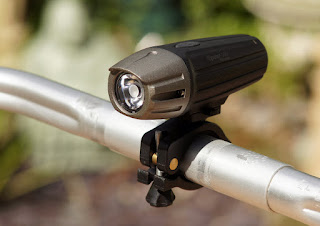September has arrived, with different,
though very positive energy. Some people feel a sense of sadness, as the leaves
turn auburn but for me, it’s always been a time of optimism. From a
journalist’s perspective, it’s time for trade shows and exciting new kit.
Testing takes on a new
dimension too. The weather is still temperate and relatively kind to
components, yet changeable enough to keep things interesting. Longer, steady
night rides, or the usual routes take on a new character, with changing light
and temperature. That said; conditions still permit lightweight, friction
busting, dirt phobic chain lubes. Since we’re on the subject, the Weldtite TF2
Ultra dry wax is holding up pretty well and as I’d expect, running very clean.
There’s no such thing as the
wrong weather, rather it’s the wrong kit.
Twenty years ago, high power
rechargeable lights commended £200. No longer does this mean a heavy lead acid
battery that consumed a bottle cage. A 900 lumen compact torch light, such as
this Xeccon spear costs less than £60 and in the highest setting, will still
run for 90minutes from a fully juiced 2600amh, replaceable cell.
At the other extreme, there’s
a town friendly, cell sipping 230 lumen mode, reckoned to deliver 6hrs 30
minutes from a full charge. I haven’t verified this, or the claims of 35 hours
in strobe. Now, I’m fully aware that auction site specials, capable of twice
this output (on paper) fuelled by relatively small lithium ion battery packs,
can be had for £20.
Sure, they’re bright but the
quality of output isn’t necessarily that good, thanks to basic lens and
reflector. Similarly, although many are offering a 500lumen and strobe settings,
the former is still overkill for suburban contexts. Again, being someone who
does a lot of miles along pitch black lanes, I’m intrigued by those boasting
big numbers.
I was particularly impressed
last year, by Moon meteor storm pro https://www.sevendaycyclist.com/moon-meteor-storm-pro-front-light
The Xeccon spear is very reminiscent of Moon LX760 that we also tested in Seven
Day Cyclist last autumn. https://www.sevendaycyclist.com/moon-lx760-front-light
It uses the same Cree XM2 diode and
follows a similar shape. However, they are two very distinct lights.
Some folks suggest this genre
have off road potential. In the sense of a quick forest or tow path short cut,
perhaps. However, the hybrid spot and floods beam is best for asphalt. Stay
tuned to Seven Day Cyclist www.sevendaycyclist.com for a
full and conclusive response. Elsewhere, at the other end, I’ve been warming to
the Xeccon Mars 60.
It’s termed a smart light and
you’d be forgiven for thinking it was 60 lumens. There’s truth in both
statements but it’s a bit more complex. Smart refers to the “Braking” function.
Regardless, which of the five
modes you’ve chosen, it detects motion. Slowing down defaults to the 60lumen,
steady mode, which is very intense at close quarters. Outside of that, 40
lumens is tops and more than sufficient for open roads. 20, or erven 10 is more
appropriate for town, especially given the braking default I’ve just mentioned.
Elsewhere, September/October
are prime times for bike prep. Give frames and components a decent helping of
high quality wax preserve, ditto shoes, saddles. There’s been sufficient
precipitation, the odd storm too, giving me the opportunity to see just how
effective the Crankalicious leather lacquer and crisp frame hybrid frame wax
are.
Both are convenient, dare I
say, nice to apply. Crisp is reckoned to last 4months between applications.
That’s true of many formulas-perfect when bikes are being put into seasonal
hibernation, or during less taxing riding conditions, so I’m looking forward to
seeing just how it holds up.
Metal frames also benefit from
a moderate helping of internal, oil based preserve. Commercially available
aerosols are convenient and for the most part, very effective. They are cheap
to manufacture and recipes vary.
Mine, developed over the past
twenty three years; is made from old/job lot candles, solvent and semi
synthetic motor oil. A small quantity poured inside the seat tube, distributed
evenly around the frame’s inner sanctum should be sufficient.
Adding more solvent will
achieve a spray able consistency but since I also use it to preserve my mk1
KA’s chassis and underside, the brush-on blend goes further, creates less clean
up and ultimately, suits my purposes best.
Bearing in mind, these can
also seal moisture in (the last thing you want) they should only be applied
while the days are relatively temperate and arid. DISCLAIMER Such “metal medicine”
is made and used entirely at your own risk. I will not be held responsible for
any accident/damage however caused. If in doubt, buy commercially available
products and seek professional advice.
Carbon composites don’t
corrode, or deteriorate in the same fashion but they are very effective
conductors. Bottom bracket sleeves, derailleur hangers and other areas are
typically aluminium alloy.
Aside from treating painted
and lacquered surfaces to decent quality waxes, strip the headset, bottom
bracket, derailleur and skewers. Treat these to a stout, high quality
ceramic/polymer grease to prevent galvanic corrosion (seizure of different
metals) and other unnecessary misery later on.
Petrochemicals aren’t kind to
rubberised seals, or suspension linkages either. I’ve found a drop of Green Oil
slip https://www.sevendaycyclist.com/green-oil-slip-eco-lubricant https://www.sevendaycyclist.com/green-oil-eco-spray-lube, or their eco-spray lube, perfect for small bushings/similar components. On that note, I’m off to prepare for a trade
show and put some more lights through their paces.







































